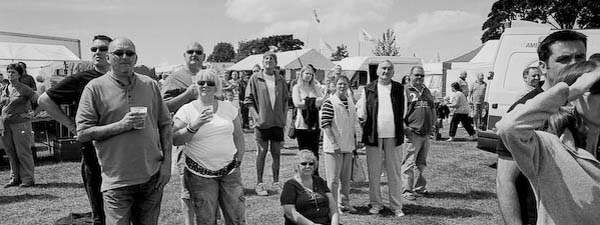Written Articles
The Festival

22/04/2011
The Festival
When you think of the festival or carnival and photography, the name Tony Ray Jones comes to the top of the list very quickly. His quiet observations of the English at play captured the humour and eccentricity of the nation. During the height of his career there was a feeling that many of the events he visited and recorded were dying out. Certainly the way we spend our pastime has changed but many of the traditions have managed to stand the test of time and some even returned after a period of inactivity. The success of any such event will depend on the dedication of a few generous individuals and also their ability to navigate local bureaucracy.
Russell Robert’s publication “Tony Ray Jones” (2005) looks in detail at legacy of Ray Jones’ work, which includes copies of his note books. These show a methodical plan to visit quite systematically as many events and locations as possible. During the 1970’s Homer Skyes was also completing his project about the annual traditions around the country. Published in 1977, “Once a Year” was a visual anthology of events that were largely unknown outside their immediate communities. In fact Skyes has continued in his dedication to this field. Many photographers do in fact overlap in their subject matter. Ray-Jones, Skyes and also Daniel Meadows all photographed the Bacup Dancers, who still not only perform at the traditional time of Easter in their home town, but also in exhibitions around the country. Despite many people’s concern that traditions would die out, it has been shown that they are in fact growing and are in a strong position for the future. Perhaps we have passed on from the selfishness shown by so many in the 1980’s, to a time where people are prepared to make some sacrifice to organise events that bring communities together.
Moving five years ago, from a small terrace house in the centre of a northern industrial city, to a semi-detached house in a village that has recently reached the national final of the “Village in Bloom” competition has brought new subject matter to my attention. Within this rural community the parades, carnival queens, fancy dress and decorated floats are still very much in evidence. Each year major roads are closed, where villages and towns come to a standstill on the road side to applaud the efforts of others hard work. Each event gives previously little known organisations opportunity to heighten their profile. Not just through raising money for charity but also to highlight the wider and perhaps more important work they do within communities.
Many people have felt that the sense of community had died and certainly Thatcher did her best to ensure the demise of society, where we knew the cost of everything but the value of nothing. However, despite this and maybe partly through the contribution of previous photographers, community events have survived, at times reborn and grown. If people can come together for the benefit of others then our communities and wider society are safe. But if the current government’s idea of a “Big Society” is a way of getting us working together on the cheap, they should remember we are intelligent enough to see through their motives and that we are capable enough not only to organise our own lives but also to record the lives of those who truly make society work. Even before the growth of digital imaging many politicians were responsible for attempting to alter history through the manipulation of photographs. As the boundary between the media, security services and government are blurred, it is therefore as important as ever that an impartial record is kept of our lives for future generations, rather than what the establishment may wish to be seen.